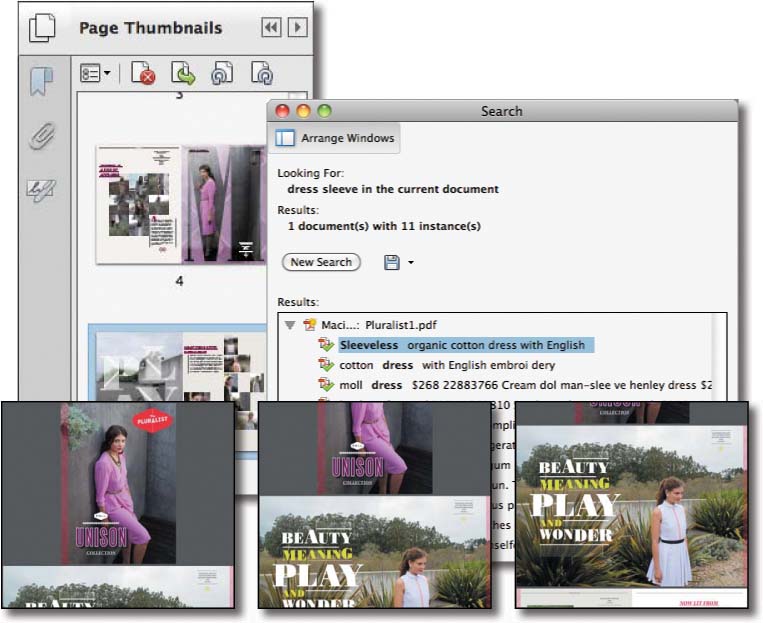3. Reading and Working with PDF Files
Lesson overview
In this lesson, you’ll do the following:
• Navigate an Adobe PDF document using tools, page thumbnails, and bookmarks.
• Change how an Adobe PDF document scrolls and displays in the document window.
• Search a PDF document for a word or phrase.
• Fill out a PDF form.
• Print all or a portion of a PDF document.
• Explore the accessibility features that make it easier for users with vision and motor impairments to use Acrobat.
• Add tags and Alt text to a PDF document.
• Share a document with others electronically.
This lesson will take approximately 60 minutes to complete. Copy the Lesson03 folder onto your hard drive if you haven’t already done so.
Get the most out of the PDF documents you create and read using navigational aids, accessibility features, search tools, and more.
Changing the opening view
You’ll open a PDF file and look at the initial view settings, and then you’ll change those settings to reflect your personal preferences.
1. In Acrobat, choose File > Open, navigate to the Lesson03 folder, and select the Pluralist.pdf file. Click Open.
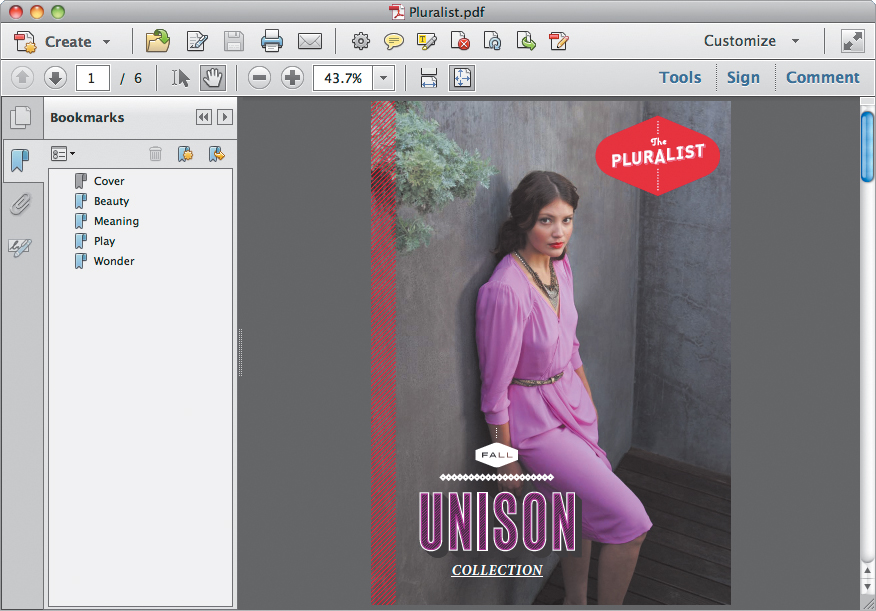
Acrobat displays the cover page with the Bookmarks panel open.
2. Choose File > Properties. Then, in the Document Properties dialog box, click the Initial View tab.

In the Layout And Magnification area, you see that the creator of this document set the file to open to page 1, with one page filling the document pane, and with the Bookmarks panel open.
Now you’ll experiment with some different opening views.
3. Choose Page Only from the Navigation Tab pop-up menu to hide the Bookmarks panel when the document opens. Change the Page Layout to Two-Up (Facing), and change the Magnification to Fit Visible. Click OK to exit the dialog box.

You need to save, close, and then reopen the file for these settings to take effect.
4. Choose File > Save As, and save the file as Pluralist1.pdf in the Lesson03 folder. Then choose File > Close to close the document.
5. Choose File > Open, and double-click the Pluralist1.pdf file to open it. Now Acrobat displays two pages, and the Bookmarks panel is hidden.
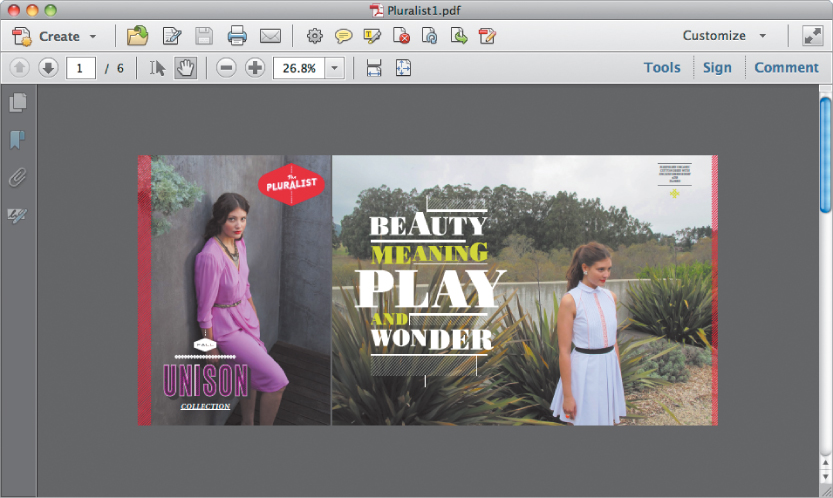
You can use the initial view settings to determine how viewers initially see documents that you create and distribute.
6. Close your file and reopen the original work file, Pluralist.pdf.
About the onscreen display
Take a look at the magnification field in the Common Tools toolbar at the top of the document window. The magnification does not refer to the printed size of the page, but rather to how the page is displayed onscreen. At 100% view, each pixel in the page is represented by one screen pixel on your monitor.
How big the page appears onscreen depends on your monitor size and resolution setting. For example, when you increase the resolution of your monitor, you increase the number of screen pixels within the same monitor area. This results in smaller screen pixels and a smaller displayed page, since the number of pixels in the page itself stays constant.
To see the printed size of your page, move your pointer into the lower left area of the document pane.
Reading PDF documents
Acrobat provides a variety of ways for you to move through and adjust the onscreen magnification of a PDF document. For example, you can scroll through the document using the scroll bar at the right side of the window, or you can turn pages as in a traditional book using the Next Page and Previous Page buttons in the Common Tools toolbar. You can also jump to a specific page.
Using Read mode
As you saw in Lesson 1, Read mode maximizes the screen space available to a document in Acrobat so you can read it more comfortably.
1. Choose View > Read Mode. In Read mode, all elements of the work area are hidden except the document pane and the menu bar.
2. Use the Page Up, Page Down, or arrow keys on your keyboard, or use the scroll bar to move through the document.
3. Move the mouse over the lower area of the document. The semi-transparent floating toolbar appears, so that you can easily move to a different page or change the magnification.
4. When you’re done reading, choose View > Read Mode again to restore the work area.

Browsing the document
You can move to different pages in a document using a variety of navigation methods.
1. If you’re not on the first page of the document, enter 1 in the page number box on the Common Tools toolbar, and press Enter or Return.
2. Choose View > Zoom > Fit Width to resize your page to fit the width of your screen.
3. Select the Hand tool (![]() ) from the Common Tools toolbar, and then position your pointer over the document. Hold down the mouse button. Notice that the pointer changes to a closed hand when you hold down the mouse button.
) from the Common Tools toolbar, and then position your pointer over the document. Hold down the mouse button. Notice that the pointer changes to a closed hand when you hold down the mouse button.
4. Drag the closed hand up and down in the window to move the page on the screen. This is similar to moving a piece of paper around on a desktop.

5. Press Enter or Return to display the next part of the page. You can press Enter or Return repeatedly to view the document from start to finish in screen-sized sections.
6. Choose View > Zoom > Zoom To Page Level, or click the Fit One Full Page button (![]() ). Click the Previous Page button (
). Click the Previous Page button (![]() ) as many times as necessary to return to page 1.
) as many times as necessary to return to page 1.
7. Click in any empty portion of the scroll bar, and click once. Or, in Windows, you can also position the pointer over the down arrow in the scroll bar and click.

The document scrolls automatically to display all of page 2. In the next few steps, you’ll control how Acrobat scrolls and displays PDF pages.
Depending on your operating system version and preferences, the scrolling behavior may be different.
You can also access the Actual Size, Zoom To Page Level, Fit Width, and Fit Visible commands by clicking the arrow to the right of the magnification pop-up menu in the Common Tools toolbar.
8. Click the Scrolling Mode button (![]() ) on the Common Tools toolbar, and then use the scroll bar to scroll to page 3 of 6.
) on the Common Tools toolbar, and then use the scroll bar to scroll to page 3 of 6.
The Scrolling Mode option displays pages end to end, like frames in a filmstrip.

9. Choose View > Page Navigation > First Page to go back to the beginning of the document.
10. Click the Fit One Full Page button (![]() ) to return to the original page layout.
) to return to the original page layout.
You can use the page number box in the Common Tools toolbar to move directly to a specific page.
11. Click in the page box so that the pointer changes to an I-beam, and then highlight the current page number.
12. Type 4 to replace the current page number, and press Enter or Return.

Acrobat displays page 4.
The scroll bar also lets you navigate to a specific page.
13. Begin dragging the scroll box upward in the scroll bar. As you scroll, a page preview box shows you the current page number. When you see page 2 of 6, release the mouse.
The second page is displayed.

Browsing with page thumbnails
Page thumbnails are miniature previews of document pages that are displayed in the Page Thumbnails panel of the navigation pane. You used page thumbnails in Lesson 1 to navigate a PDF document.
Now, you’ll gain more experience with page thumbnails, as you use them to change the view of pages. In Lesson 4, “Enhancing PDF Documents,” you’ll learn how to use page thumbnails to reorder pages in a document.
1. Choose View > Zoom > Fit Width, or click the Scrolling Mode button to view the full width of the page. You should still be looking at page 2.
2. Click the Page Thumbnails button (![]() ) in the navigation pane to open the Page Thumbnails panel.
) in the navigation pane to open the Page Thumbnails panel.
Acrobat automatically displays page thumbnails for every page in the document in the navigation pane. The page thumbnails represent both the content and page orientation of the pages in the document. Page-number boxes appear beneath each page thumbnail.
3. Click the page 5 thumbnail to go to page 5. You may need to scroll down through the thumbnails to see the one for page 5.
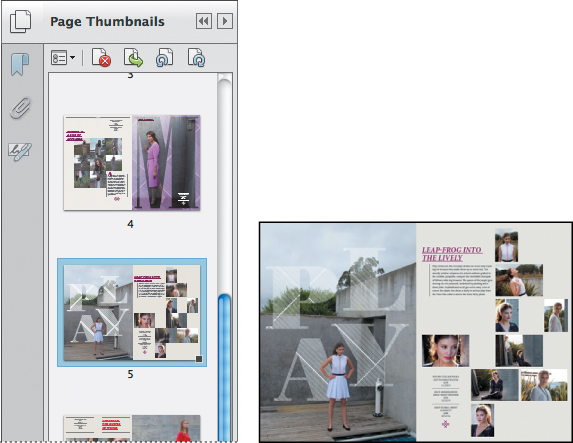
The page number for the page thumbnail is highlighted, and a full-width view of page 5 appears in the document window.
Take a look at the page 5 thumbnail. The rectangle inside the page thumbnail, called the page-view box, represents the area displayed in the current page view. You can use the page-view box to adjust the area and magnification of the page being viewed.
4. Position the pointer over the lower right corner of the page-view box. The pointer turns into a double-headed arrow.
5. Drag to shrink the page-view box, and release the mouse button. In the Common Tools toolbar, the magnification level has changed to represent the smaller area.
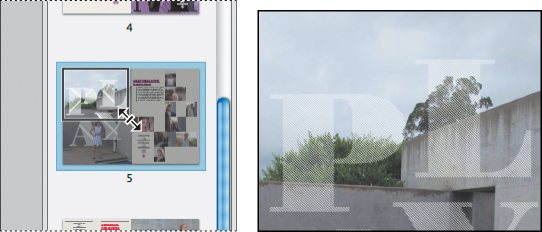
6. Position the pointer over the bottom border of the page-view box. The pointer changes to a hand.
7. Drag the page-view box within the page thumbnail, and watch the view change in the document window.
8. Drag the page-view box over to focus your view on the text titled “Leap-frog into the lively.”
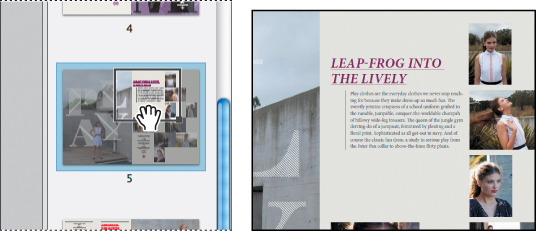
Page thumbnails provide a convenient way to monitor and adjust your page view in a document.
9. Click the Page Thumbnails button to hide the panel.
Changing the page view magnification
You can change the magnification of the page view using controls in the Common Tools toolbar.
1. Choose View > Zoom > Fit Width, or click the Scrolling Mode button. A new magnification appears.
2. Click the Previous Page button (![]() ) as many times as necessary to move to page 3. Notice that the magnification remains the same.
) as many times as necessary to move to page 3. Notice that the magnification remains the same.
3. Choose View > Zoom > Actual Size to return the page to a 100% view.
4. Click the arrow to the right of the magnification text box to display the preset magnification options. Choose 200%.
You can also type in a specific value for the magnification in the text box.
5. Click the arrow to the right of the magnification box, and choose Actual Size to display the page at 100% again.
Next, you’ll use the Zoom In button to magnify the view.
6. Select the page number, type 6, and press Enter or Return to go to page 6.
7. Click the Zoom In button (![]() ) once.
) once.
8. Click the Zoom In button again to further increase the magnification.
Each click on a Zoom button increases or decreases the magnification by a set amount.
9. Click the Zoom Out button (![]() ) twice to return the view to 100%.
) twice to return the view to 100%.
Now you’ll use the Marquee Zoom tool to magnify the image. The Marquee Zoom tool is hidden by default, so you’ll add it to the Common Tools toolbar.
10. Choose View > Show/Hide > Toolbar Items > Select & Zoom > Marquee Zoom to display the Marquee Zoom tool in the Common Tools toolbar.
11. Select the Marquee Zoom tool (![]() ). Position the pointer near the upper left corner of the image that includes the letter “O,” and drag to the lower right corner.
). Position the pointer near the upper left corner of the image that includes the letter “O,” and drag to the lower right corner.
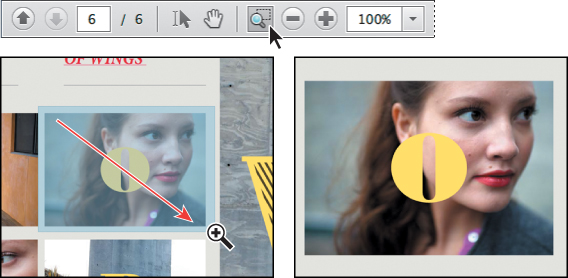
The view zooms in on the area you enclosed. This is called marquee-zooming.
12. Choose View > Zoom > Zoom To Page Level.
You can show or hide other tools in the Common Tools toolbar by choosing View > Show/Hide > Toolbar Items, selecting a category, and then selecting the tool you want to display or hide.
Using the Dynamic Zoom tool
The Dynamic Zoom tool lets you zoom in or out by dragging the mouse up or down.
1. Choose View > Show/Hide > Toolbar Items > Select & Zoom > Dynamic Zoom to add the Dynamic Zoom button to the Common Tools toolbar, if it’s not already there.
2. Select the Dynamic Zoom tool (![]() ).
).
3. Click in the document pane. Drag upward to zoom in, and drag down to zoom out.
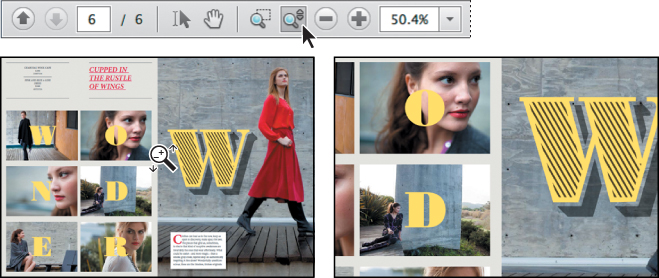
4. When you’re finished, select the Hand tool, and then click the Fit One Full Page button (![]() ).
).
Following links
In a PDF document, you don’t have to view pages in sequence. You can jump immediately from one section of a document to another using custom navigational aids such as links.
One benefit of working with electronic documents is that you can convert traditional cross-references into links, which users can use to jump directly to the referenced section or file. For example, you can make each item in a table of contents into a link that jumps to its corresponding area in the document. You can also use links to add interactivity to traditional book elements such as glossaries and indexes.
First you’ll add some navigational tools to the Common Tools toolbar.
1. Choose View > Show/Hide > Toolbar Items > Page Navigation > Show All Page Navigation Tools.
Now you’ll use an existing link to move to a specific area in the document.
2. Click the First Page button (![]() ) in the Common Tools toolbar to return to the first page, and then click the Next Page button (
) in the Common Tools toolbar to return to the first page, and then click the Next Page button (![]() ) to move to page 2.
) to move to page 2.
3. Move the pointer over the word “Beauty.” The Hand tool changes to a pointing finger, indicating the presence of a link. Click to follow the link.
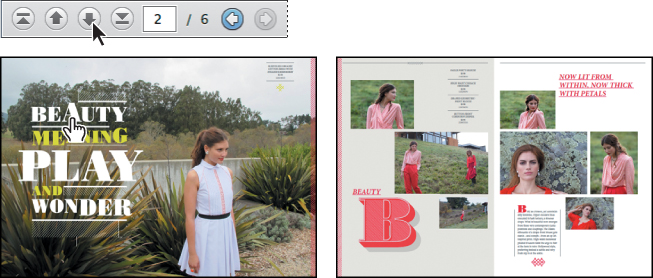
This link sends you to page 3.
4. Click the Previous View button (![]() ) to return to your previous view of page 2.
) to return to your previous view of page 2.
You can click the Previous View button at any time to retrace your viewing path through a document. The Next View button reverses the action of your last Previous View.
You have learned how to page through a PDF document, change the magnification and page layout mode, and follow links.
5. To restore the default toolbar configuration, choose View > Show/Hide > Toolbar Items > Reset Toolbars. Click OK to confirm that you want to restore the defaults.
Searching PDF documents
You can quickly search through a PDF document, looking for a word or a phrase. If, for example, you didn’t want to read through this document but simply wanted to find occurrences of the word blouse, you can use either the Find feature or the Search feature to locate that information. The Find feature locates a word or phrase in the active document. The Search feature locates a word or phrase in one document, across a selection of documents, or in a PDF Portfolio. Both features search text, layers, form fields, and digital signatures.
First you’ll run a simple Find operation on the open document.
1. Choose Edit > Find. In the text box in the toolbar that appears in the upper right corner of the application window, type blouse.
To see the options available with the Find feature, click the arrow on the right side of the text box. You can use these options to refine your search, looking for whole words only or specifying uppercase or lowercase letters, and you can also include bookmarks and comments in the search. An option is in effect (on) when there is a check mark next to its name.
2. Press Enter or Return to start the Find operation.
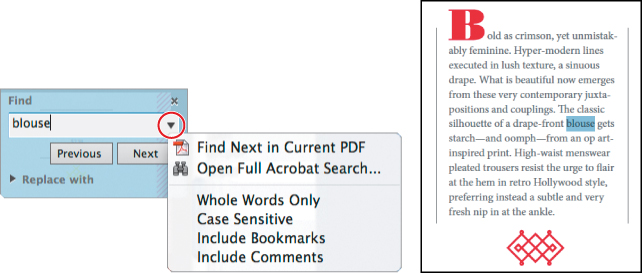
The first occurrence of blouse is highlighted on page 3 of the document.
3. Click the Next button in the Find panel to find the next occurrence of the word. Acrobat reports that it found no more matches. Click OK to close the dialog box, and then close the Find panel.
Next, you’ll perform a more sophisticated search of the document using the Search feature. In this exercise, you’ll search only one document, but you can use the Search feature to search all documents in a folder as well as all documents in a PDF Portfolio. You can even search non-PDF files in a PDF Portfolio.
4. Choose Edit > Advanced Search.
5. To search only the open document, select In The Current Document.
In this search, we’d like to find references to sleeves or dresses.
6. In the Search text box, enter dress sleeve.
7. Click the Show More Options link at the bottom of the Search pane.
8. From the Return Results Containing pop-up menu, choose Match Any Of The Words. This ensures that the search will return all results for “dress” or “sleeve,” including words that contain additional letters, such as “address.”
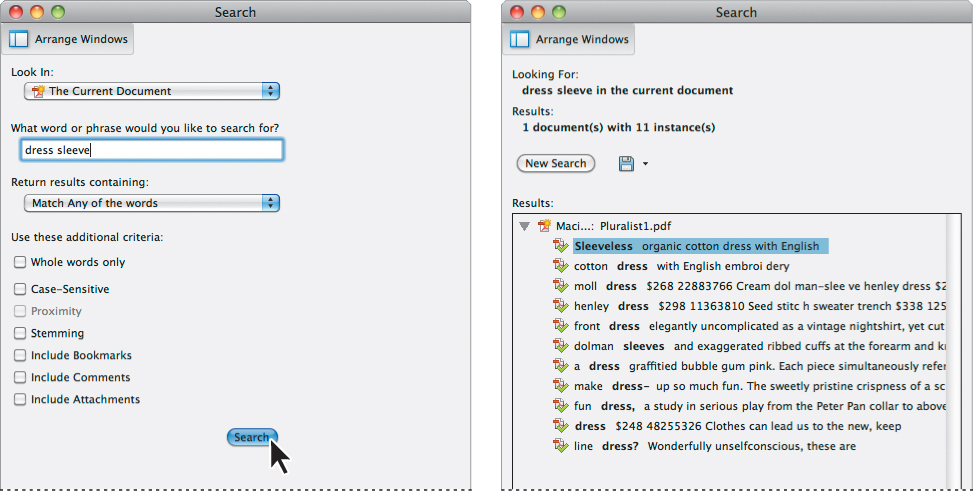
You can also save your search results in Acrobat XI: Click the Save icon next to the New Search button in the Search pane, and then choose either Save Results To PDF or Save Results To CSV.
The search results are displayed in the Search pane.
10. Click any search result to go to the page that contains that information.

You can check any of the other search results in the Search pane by clicking them.
11. When you’re finished, close the Search pane.
The Search feature searches object data and image metadata. When you search multiple PDF documents, Acrobat also looks at the document properties and XMP metadata. If any of your PDF documents have attachments, you can also include those attachments in the search. If you include a PDF index in your search, Acrobat searches indexed structure tags. To search an encrypted document, you must first open the document.
Printing PDF documents
Many of the options in the Acrobat Print dialog box are similar to those you’d find in the Print dialog boxes of other popular applications. For example, you can select a printer and set up parameters such as paper size and orientation. However, Acrobat also gives you the flexibility to print only the current view (that is, what is displayed on the screen at that moment), a selection, a specific page, selected pages, or a range of pages within the PDF file.
You’ll instruct Acrobat to print pages you select in the Page Thumbnails panel, a particular view, and discontiguous pages.
1. In the Pluralist.pdf document, click the Page Thumbnails button in the navigation pane. Then click three thumbnails to select the pages you want to print. You can Ctrl-click (Windows) or Command-click (Mac OS) page thumbnails to select contiguous or discontiguous pages.
2. Choose File > Print. Select the name of the printer you want to print to. Because you selected pages in the Page Thumbnails panel, the Selected Pages option is selected automatically in the Print dialog box.
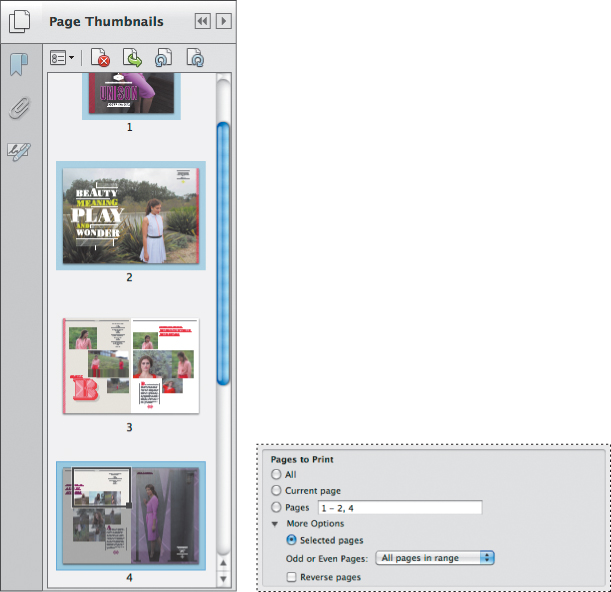
3. Click OK or Print to print your selected pages. Click Cancel if you want to abort the printing operation.
If you need help troubleshooting a printing issue, click the Help link in the upper right corner of the Print dialog box to go to the Adobe website for the latest printing tips and information.
4. After the pages print (or the Print dialog box closes, if you opted not to print), deselect any thumbnails, and then close the Page Thumbnails panel.
5. Go to page 5 of the document.
6. Zoom in to 200%, and then use the Hand tool to shift the page so that you see only the model and part of the word “play.”
7. Choose File > Print, and select the name of the printer you want to print to.
8. In the Pages To Print area, click More Options. Then select Current View. The preview changes to represent what is currently visible in the document pane.
If you print with Current View selected, Acrobat prints only the contents of the document pane. However, you’ll select pages to print instead.
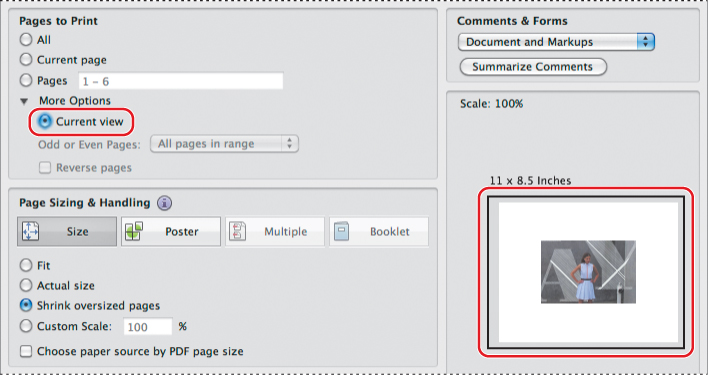
9. In the Pages To Print area, select Pages.
10. In the Pages text box, type 1, 3-4, 6. If you click OK or Print now, Acrobat will print pages 1, 3, 4, and 6. You can enter any set of discontiguous pages or ranges of pages, using commas, in this text box.
11. If you want to print the pages you’ve selected, click OK. If you don’t want to print, click Cancel.
12. Choose File > Close to close the Pluralist.pdf document.
For information on printing comments, see Lesson 9, “Using Acrobat in a Review Cycle.”
If your PDF file contains odd-sized pages, you can use the Size options in the Page Sizing & Handling area of the Print dialog box to reduce, enlarge, or divide pages. The Fit option scales each page to fit the printer page size; pages in the PDF file are magnified or reduced as necessary. The Poster options let you tile oversize pages, printing portions of them on several pages that can be assembled to reproduce the oversize image. In Windows, you can also specify that the paper source be determined by the document’s page size.
Filling out PDF forms
PDF forms can be interactive or noninteractive. Interactive PDF forms have built-in form fields and behave in much the same way as most forms that you encounter on the web or that are sent to you electronically. You enter data using the Selection tool or Hand tool in Acrobat or Adobe Reader.
Noninteractive PDF forms (flat forms) are pages that have been scanned to create a facsimile of a form. These pages do not contain actual form fields; they contain only the images of form fields. Traditionally you would print out these forms, fill them out by hand or using a typewriter, and then mail or fax the hard copy. With Acrobat, you can fill out these noninteractive or flat forms online using the Add Text tool.
For information on creating and managing interactive forms, see Lesson 10, “Working with Forms in Acrobat.”
You’ll fill out fields in an interactive form, and then add information where there is no field using the Add Text tool.
1. Choose File > Open, and navigate to the Lesson03 folder. Select the Registration.pdf file, and click Open.
Acrobat displays a purple bar across the top of the document, requesting that you fill out the form. By default, it highlights the form fields.
2. With the Hand tool (![]() ) selected, click in the Address field. Enter an address. The text appears in the font and type size chosen by the form creator.
) selected, click in the Address field. Enter an address. The text appears in the font and type size chosen by the form creator.
3. Choose a state (there are four listed) from the State pop-up menu.

Some fields, such as Address and Email Address, require you to type in text, while check boxes and radio buttons require you only to click to select them. The Email My Reply button performs an action when you click it.
The person who created this form forgot to create an interactive field for the name. You’ll add text without requiring a field.
4. In the Tools pane, open the Content Editing panel. Then click Add Text.
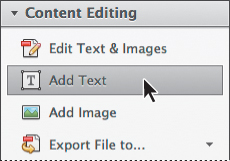
Text formatting options appear in the Content Editing panel.
5. Click next to the Name text. The pointer is an I-beam with a horizontal line beneath it.
6. Type your name.
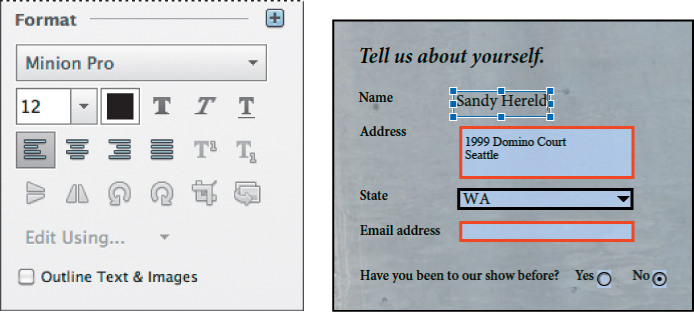
You can use the Add Text tool to add text to any PDF file, unless security applied to the document prohibits it.
7. Select the Hand tool again, and select Yes for the last question on the form. Then select No. Only one radio button can be selected at a time, so if you select one, the other is deselected.
8. Choose File > Save As, and save a copy of the form in the Lesson03 folder, using the filename Registration_complete.pdf.
You can open the saved file if you wish to verify that all your data was saved.
9. Choose File > Close to close the order form.
About flexibility, accessibility, and structure
The accessibility and flexibility of your Adobe PDF files determine how easily vision- and motion-impaired users and users of hand-held devices can access, reflow, and—if you allow it—reuse the content of your files. You control the accessibility and flexibility of your Adobe PDF files through the amount of structure you build into the source file and the method you use to create the Adobe PDF file.
By making your PDF documents more accessible to users, you can broaden your readership and better meet government standards for accessibility. Accessibility in Acrobat falls into two categories:
• Accessibility features that help authors create accessible documents from new or existing PDF documents. These features include simple methods for checking accessibility and adding tags to PDF documents. With Acrobat Pro, you can also correct accessibility and reading-order problems in PDF files by editing the PDF file structure.
• Accessibility features that help readers who have motion or vision limitations to navigate and view PDF documents more easily. Many of these features can be adjusted by using a wizard, the Accessibility Setup Assistant.
For Adobe PDF files to be flexible and accessible, they must have structure. Adobe PDF files support three levels of structure—tagged, structured, and unstructured. Tagged PDF files have the most structure. Structured PDF files have some structure, but are not as flexible or accessible as tagged PDF files. Unstructured PDF files have no structure. (As you will see later in this lesson, you can add limited structure to unstructured files.) The more structure a file has, the more efficiently and reliably its content can be reused.
Structure is built into a document when, for example, its creator defines headers and columns, adds navigational aids such as bookmarks, and adds alternate text descriptions for graphics. In many cases, documents are automatically given logical structure and tags when they are converted to Adobe PDF.
When you create PDFs from Microsoft Office files or from files created in later versions of Adobe FrameMaker®, InDesign, or Adobe PageMaker®, or when you create Adobe PDF files from websites, the resulting PDF files are tagged automatically.
In Acrobat Pro, if your PDF documents don’t reflow well, you can correct most problems using the Accessibility panel or the TouchUp Reading Order tool. However, this is not as easy as creating a well-structured document in the first place. For an in-depth guide to creating accessible PDF documents, visit www.adobe.com/accessibility.
Working with accessible documents
If you’re working with Acrobat Pro, you’ll examine a tagged PDF document. In either Acrobat Standard or Pro, you’ll see how easy it is to reflow the document and extract content.
Checking for accessibility (Acrobat Pro only)
It’s always a good idea to check the accessibility of any Adobe PDF document before you distribute it to users. The Accessibility Checker panel tells you if your document has the information necessary to make it accessible. At the same time, it checks for protection settings that would prohibit access.
First you’ll look at the accessibility and flexibility of a tagged PDF file that was created from a Microsoft Word file.
1. Choose File > Open, navigate to the Lesson03 folder, and double-click the Tag_Wines.pdf file.
2. Choose File > Save As, and save the file as Tag_Wines1.pdf in the Lesson03 folder.
3. In the Tools pane, open the Accessibility panel. If the Accessibility panel isn’t listed, choose View > Tools > Accessibility to open it.
By default, Acrobat displays only some of the panels in the Tools pane. To select which panels appear in the list, click the menu button at the top of the Tools pane, and then select or deselect individual panels.
4. In the Accessibility panel, click Full Check.
5. Accept the defaults in the Accessibility Checker Options dialog box, and click Start Checking.
Acrobat quickly checks the document for accessibility issues, and displays the interactive Accessibility Checker panel in the navigation pane. There are some issues with this document.
6. Expand the Document category. It lists three issues. Two of those issues are items that require you to look at the document to determine whether there’s a problem (Logical Reading Order and Color Contrast). The third issue is the Title, which failed.

In an accessible document, the document title should be included and set to display automatically in the title bar. You can learn what each item in the Accessibility Checker panel refers to by choosing Explain from the Options menu at the top of the panel.
7. Right-click or Control-click the Title item, and choose Fix.
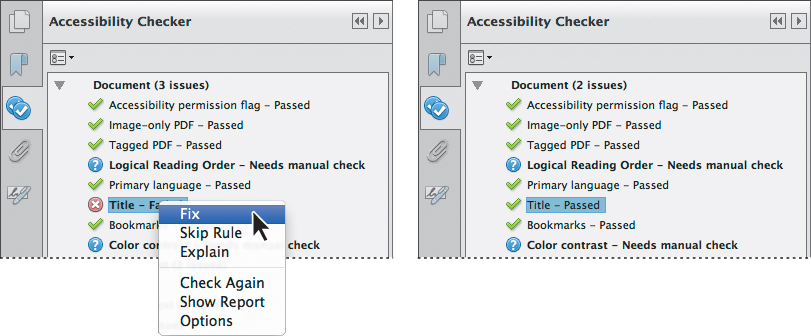
The panel changes to show that the title passed, after Acrobat changed its settings. Had there not been a title already in the document, you’d have been prompted to enter the document title. You can quickly fix most accessibility issues in a document using the interactive Accessibility Checker panel.
8. Close the Accessibility Checker panel and the Tools pane.
You can add security to your PDF files and still make them accessible. The encryption offered by Acrobat XI prevents users from copying and pasting text from a PDF file, while still supporting assistive technology.
Reflowing a flexible PDF file (Standard and Pro)
Now you’ll take a quick look at how flexible a tagged PDF file is. You’ll reflow the PDF file, and then you’ll save the contents of the PDF file as accessible text.
First, you’ll adjust the size of your document window to mimic the smaller screen of a hand-held device.
1. Choose View > Zoom > Actual Size to display the document at 100%.
2. Resize the Acrobat window to about 50% of the full-screen display. In Windows, click the Maximize/Restore Down button if the window is currently maximized; if the window isn’t maximized, drag a corner of the application window to reduce it. In Mac OS, resize the document pane by dragging a corner.
Your goal is to resize the Acrobat window so that the ends of the sentences in the document pane are cut off.
3. Choose View > Zoom > Reflow.
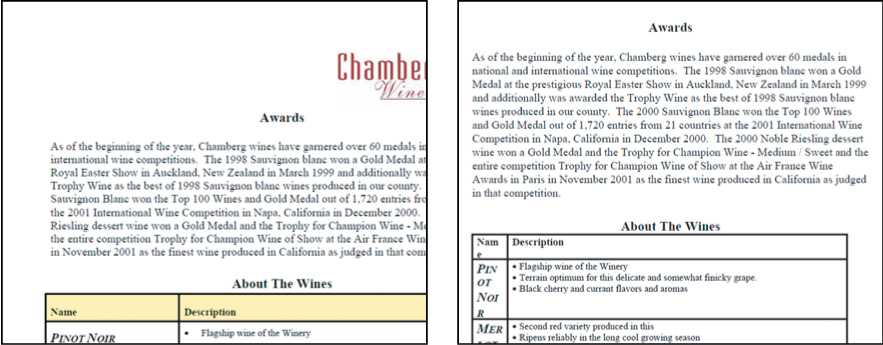
The content of the document is reflowed to accommodate the smaller document screen, and you can now read an entire line of text without using the horizontal scroll bar.
When you reflow text, artifacts such as page numbers and page headers often drop out because they are no longer relevant to the page display. Text is reflowed one page at a time. You cannot save the document in the reflowed state.
Now you’ll examine how the display changes when you change the magnification.
4. Choose 400% from the magnification pop-up menu.
5. Scroll down the page to see how the text reflows. Again, because the text is reflowed, you don’t have to use the horizontal scroll bar to move back and forth across the page to read the enlarged text. The text is automatically contained within the document pane.
6. When you’ve finished viewing the reflowed text, restore the Acrobat document window to its usual size, and close the file.
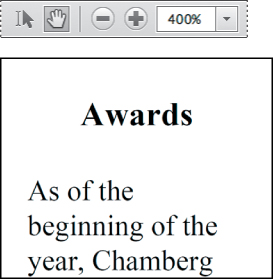
You can save the contents of a tagged document in a different file format for reuse in another application. For example, if you save this file as accessible text, you’ll see that even the contents of the table are saved in an easy-to-use format.
With Acrobat, you can even make some unstructured documents more readily accessible to all types of users. You can add tags to a PDF document using the Add Tags To Document command in any version of Acrobat. However, to correct tagging and order errors, you must be using Acrobat Pro.
Making files flexible and accessible (Acrobat Pro only)
Some tagged Adobe PDF documents may not contain all the information necessary to make their contents fully flexible or accessible. For example, your file may not contain alternate text for figures, language properties for portions of the text that use a different language than the default language for the document, or expansion text for abbreviations. (Designating the appropriate language for different text elements ensures that the correct characters are used when you reuse the document for another purpose, that the word can be pronounced correctly when read out loud, and that the document will be spell-checked with the correct dictionary.)
If you’re using Acrobat Pro, you can add alternate text and multiple languages using the Tags panel. (If only one language is required, it is easier to choose the language in the Document Properties dialog box.) You can also add alternate text using the TouchUp Reading Order tool.
You can add tags and alternate text using tools in the Accessibility panel in Acrobat Standard.
Now you’ll look at the accessibility of a page of a user guide. This document was designed to be printed, so no attempt was made to make it accessible.
1. Choose File > Open, and open the AI_UGEx.pdf file in the Lesson03 folder.
2. Open the Tools pane. Then, in the Accessibility panel, click Full Check, and click Start Checking.
The Accessibility Checker panel indicates that the document isn’t tagged (in the Document category).
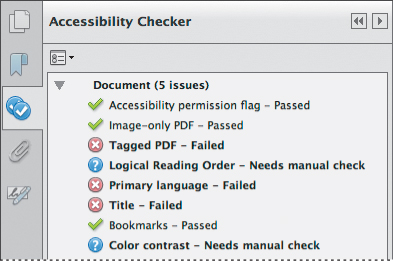
3. Close the Accessibility Checker panel and the Tools pane.
Now you’ll see how this page reflows.
4. Choose View > Zoom > Actual Size to display the document at 100%.
5. Reduce the size of the document pane: In Windows, click the Maximize/Restore Down button if the window is maximized; if it isn’t, drag a corner of the window. In Mac OS, drag a corner of the document pane to resize it. Resize the Acrobat window small enough that the width of a full page cannot be displayed on the screen (at 100%).
6. Choose View > Zoom > Reflow.
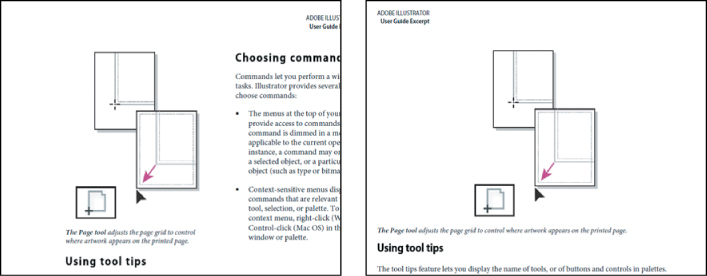
The text reflows well, despite the lack of structure.
7. Choose View > Zoom > Zoom To Page Level. Resize the Acrobat window to its usual size.
Acrobat is able to reflow even this unstructured document relatively well. However, the lack of structure in the document makes it inaccessible in other ways. You can add tags and other structure to improve the flexibility and accessibility of the page.
Using the Make Accessible action
If you’re using Acrobat Pro, you can systematically ensure your PDF document is accessible using the Make Accessible action. You’ll use the action to set document properties, set the tab order, add tags, and add alternate text to the document.
The Make Accessible action is one of the default actions in the Action Wizard in Acrobat Pro. You’ll learn more about using and creating actions in Lesson 12, “Using Actions.”
1. Open the Tools pane, and then open the Action Wizard panel.
2. Click Make Accessible in the Actions area of the panel.
The Tools pane is replaced with the Make Accessible action pane, which lists the steps included in the action. The action automates steps when possible, and guides you through the steps you need to perform to make your document accessible.
3. Verify that the file in the Files To Be Processed box is AI_UGEx.pdf.
4. Click Start.

The first section of the Make Accessible action helps you prepare your document settings for flexibility and accessibility.
5. In the Description dialog box, change the title to User Guide, and click OK.
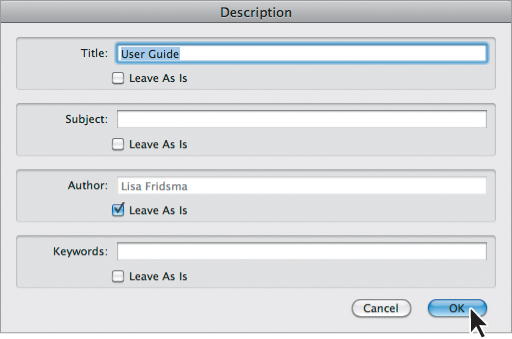
The title in the Description dialog box is the title that will appear in the title bar when the document is opened. After you click OK, Acrobat performs the next step automatically, setting the appropriate Open options for the document.
6. Accept the default settings in the Recognize Text - General Settings dialog box, and click OK.
These settings determine how OCR is applied to recognize text for screen readers.
7. When asked whether this document is intended to be a fillable form, click No, Skip This Step.
If this were a form, Acrobat would detect the form fields.
8. Click OK in the Set Reading Language dialog box to accept English as the reading language.

Acrobat automatically performs the next step, adding tags to the document.
9. Click OK when alerted that Acrobat will display any figures with missing alternate text.
Screen readers use alternate text (often called alt text) to describe non-text elements such as images or figures to a visually impaired person. Acrobat examines your document to ensure that every image has alternate text assigned to it, and prompts you to assign text where it’s missing.
10. In the Set Alternate Text dialog box, type Page Tool as the alt text for the selected image. Then click Save & Close.
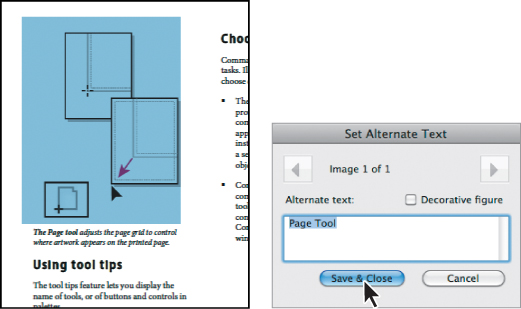
11. Click Start Checking in the Accessibility Checker Options dialog box to confirm that the document is now accessible.
The Accessibility Checker panel now shows only two issues, both items that you need to confirm manually.
12. Click Close at the top of the action pane to exit the action. Close the Accessibility Checker panel, too.
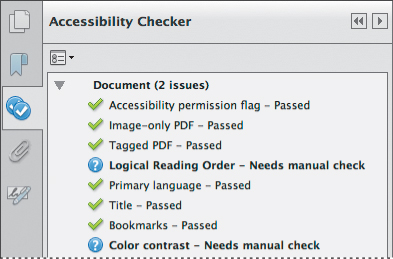
The Recognition Report is a temporary file and can’t be saved. The Full Check feature generates an accessibility report that you can save.
Using Acrobat accessibility features (Standard and Pro)
Many people with vision and motor impairments use computers, and Acrobat has a number of features that make it easier to work with PDF files. Such features include:
• Automatic scrolling
• Keyboard shortcuts
• Support for several screen-reader applications, including the text-to-speech engines built into Windows and Mac OS platforms
• Enhanced onscreen viewing
Using the Accessibility Setup Assistant
Both Acrobat XI and Adobe Reader include an Accessibility Setup Assistant that launches automatically the first time the software detects a screen reader, screen magnifier, or other assistive technology on your system. (You can also launch the Assistant manually at any time by selecting Setup Assistant in the Accessibility panel in Acrobat, or by choosing Edit > Accessibility > Setup Assistant in Reader.) The Accessibility Setup Assistant walks you through setting the options that control how PDF documents appear onscreen. You can also use it to set the option that sends print output to a Braille printer.
A full explanation of the options you can set in the Accessibility Setup Assistant is available in Adobe Acrobat XI Help. The options available depend on the type of assistive technology you have on your system. The first panel of the Accessibility Setup Assistant requires you to identify the type of assistive technology you use:
• Select Set Options For Screen Readers if you use a device that reads text and sends output to a Braille printer.
• Select Set Options For Screen Magnifiers if you use a device that makes text appear larger on the screen.
• Select Set All Accessibility Options if you use a combination of assistive devices.
• Click Use Recommended Settings And Skip Setup to use the settings Adobe recommends for users with limited accessibility. (Note that the preferred settings for users with assistive technology installed are not the same as the default Acrobat settings for users who are not using assistive technology.)
In addition to the options you can set using the Accessibility Setup Assistant, you can select a number of options in the Acrobat or Adobe Reader preferences that control automatic scrolling, reading-out-loud settings, and reading order. You may want to use some of these options even if you don’t have assistive technology on your system. For example, you can set your Multimedia preferences to show available descriptions for video and audio attachments.
If you opened the Accessibility Setup Assistant, click Cancel to exit the dialog box without making any changes.
About automatic scrolling
When you’re reading a long document, the automatic scrolling feature saves you keystroke and mouse actions. You can control the speed of scrolling, scroll backward and forward, and exit automatic scrolling with a single keystroke.
Now you’ll test the automatic scroll feature.
1. Choose File > Open, and open the Pluralist.pdf file. If necessary, resize the Acrobat window to fill your desktop, and select the Hand tool (![]() ).
).
2. Choose View > Page Display > Automatically Scroll.

3. You can set the rate of scrolling using the number keys on your keyboard. The higher the number, the faster the rate of scrolling. Try pressing 9, and then pressing 1, for example, to change the rate of scrolling. To exit automatic scrolling, press the Esc key.
About keyboard shortcuts
For some common commands and tools, the keyboard shortcut is displayed next to the command or tool name. A list of keyboard shortcuts is available in Adobe Acrobat XI Help.
You can also use the keyboard to control Acrobat within a web browser. If the focus is on the web browser, any keyboard shortcuts you use act according to the web browser settings for navigation and selection. Pressing the Tab key shifts the focus from the browser to the Acrobat document and application, so navigation and command keystrokes function normally. Pressing Ctrl+Tab shifts the focus from the document back to the web browser.
Changing the background color
Now you’ll experiment with changing the color of the background. Note that these changes affect only the onscreen display on your own system; they do not affect the printed document, nor are they saved with the document for display on systems other than your own.
1. Choose Edit > Preferences (Windows) or Acrobat > Preferences (Mac OS), and select Accessibility from the list of categories on the left.
2. Select the Replace Document Colors option.
3. Select Custom Color.
4. Click the Page Background color square to open the color picker.
5. You can select a color from the color picker or you can select a custom color. We chose pale gray.

6. Click OK to apply your changes.
7. View the PDF file in Acrobat. The background color of the page has changed to the color you specified.
8. When you are finished, leave your background color as it is, select a different color, or return it to white.
In the Forms preferences, you can also change the background color of form fields and the color displayed in form fields when your pointer moves over them. You can change the background color for full-screen presentations in the Full Screen preferences. You can change the underline color used in the spell-check feature to identify misspelled words in the Spelling preferences.
Smoothing text
You can smooth text, line art, and images to improve onscreen readability, especially with larger text sizes. If you use a laptop or if you have an LCD screen, you can also choose a Smooth Text option to optimize your display quality. Set the options to smooth text in the Page Display preferences.
Magnifying bookmark text
You can increase the text size used in bookmark labels.
1. Click the Bookmarks button to display the Bookmarks panel, if it’s not already open.
2. Choose Text Size > Large from the options menu of the Bookmarks panel.
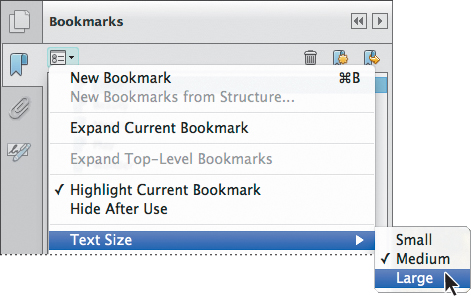
3. Restore your bookmark text size to medium.
You may want to experiment with screen-display options and other accessibility controls to find a combination that best suits your needs.
4. When you are finished, choose File > Close. You need not save your work.
Setting screen reader and reading-out-loud preferences
After you have installed your screen reader or similar application and set it up to work with Acrobat, you can set the screen reader preferences in Acrobat. You set these preferences in the same panel in which you set the Read Out Loud feature preferences that control the volume, pitch, and speed of the speech; the nature of the voice; and the reading order preferences.
Newer systems (both Windows and Mac OS) have built-in text-to-speech engines. Although the Read Out Loud feature can read the text of a PDF file out loud, it is not a screen reader. Not all systems support the Read Out Loud feature.
In this exercise, you’ll look at the preferences that affect how Adobe PDF documents are read out loud. Unless you have text-to-speech software on your system, you do not need to set these preferences.
1. Choose File > Open, and open the Tag_Wines.pdf file.
2. If your system has text-to-speech software, choose View > Read Out Loud > Activate Read Out Loud.
3. After you have activated the Read Out Loud feature, choose View > Read Out Loud > Read This Page Only. Acrobat reads the page that is currently displayed. To stop the reading, press Shift+Ctrl+E (Windows) or Shift+Command+E (Mac OS).
You can experiment with the reading options.
4. Choose Edit > Preferences (Windows) or Acrobat > Preferences (Mac OS), and select Reading from the list on the left. Experiment, if you like.
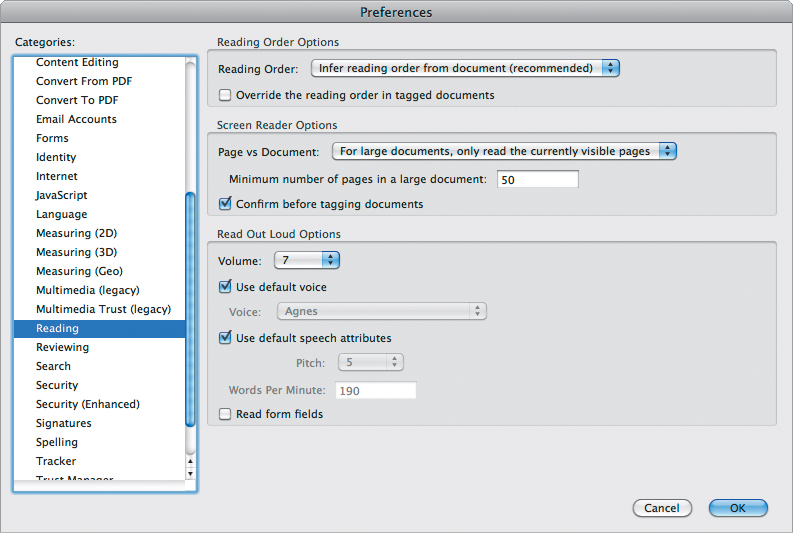
You can control the volume, pitch, speed, and voice used. If you use the default voice, you cannot change the pitch and speed of delivery.
If your system has limited memory, you may wish to reduce the number of pages Acrobat reads before data is delivered page by page. The default value is 50 pages.
5. Click OK in the Preferences dialog box to apply any changes that you make. Or click Cancel to exit the Preferences dialog box without making any changes.
6. To test the settings you changed, choose View > Read Out Loud > Read This Page Only.
7. To stop the reading, press Ctrl+Shift+E (Windows) or Command+Shift+E (Mac OS).
Sharing PDF files
You can share a PDF document with other people by posting it on a website, burning it to a disc, or sending it as an email attachment. Acrobat makes it easy to distribute a PDF document to others by attaching the document to an email message or using Adobe SendNow.
Sending email attachments
You can send a PDF file as an attachment to a message you send from an email application on your computer (such as Microsoft Outlook) or from a webmail application such as Gmail or Yahoo Mail.
1. With the Tag_Wines.pdf file open, click the Send Email button (![]() ) in the Quick Tools toolbar.
) in the Quick Tools toolbar.
2. In the Send Email dialog box, select either Default Mail Application or Use Webmail. If you select Use Webmail, choose a webmail service from the pop-up menu, and then add the account.
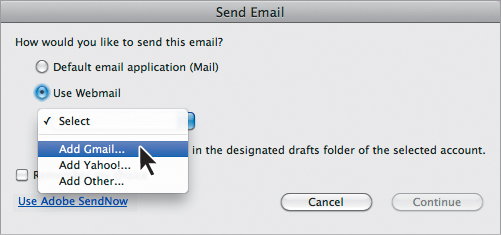
Once you’ve added a webmail account, it appears in the pop-up list so you can select it directly.
3. Click Continue.
4. If you’re using a webmail account, sign in, and grant access to Acrobat if prompted.
Your email application or webmail program opens with a draft message that has the file attached to it. If you’re using Gmail, you may need to click Drafts to see the draft message.
5. Enter email addresses, a subject line, and a brief message.
6. Send the message.
Using Adobe SendNow
Adobe SendNow uploads a document to Acrobat.com, a secure web service. It sends email to the recipients you specify so that they can read the file online or download it. You need a free Adobe ID to upload files to Acrobat.com.
1. With the Tag_Wines.pdf file open, click the Send Email button (![]() ) in the Quick Tools toolbar.
) in the Quick Tools toolbar.
2. In the Send Email dialog box, click Use Adobe SendNow. Acrobat automatically opens the Adobe SendNow website in a web browser.
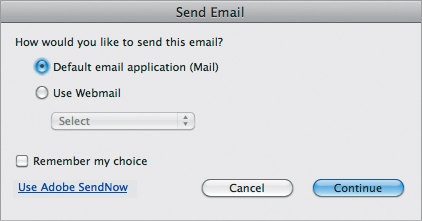
3. Click Sign In. Then sign in if you have an Adobe ID. If you don’t have an Adobe ID, click Create An Account For Free and follow the onscreen prompts to create an account.
4. When the Adobe SendNow utility appears, click Select File, and then navigate to the Tag_Wines.pdf file in the Lesson03 folder, and click Open.
5. Enter the email addresses of people you want to notify about the document, separating the addresses with semicolons or returns. For this exercise, enter your own email address.
6. Enter a subject and a simple message, and then click Send Now.
Acrobat uploads the document and then sends email to recipients with a link to the uploaded file.
7. Close the web browser, and then close any open documents and applications.
Review questions
1. Name three methods you can use to navigate to a different page within a document in Acrobat XI.
2. Name two ways to change the view magnification in a PDF file.
3. How can you determine whether a PDF document is accessible when you’re working with Acrobat Pro?
4. How can you print pages that are not next to each other (that is, discontinguous pages) from Acrobat?
Review answers
1. You can move to a different page by clicking the Previous Page or Next Page button in the Page Navigation toolbar; dragging the scroll box in the scroll bar; entering a page number in the page box in the Page Navigation toolbar; or clicking a bookmark, page thumbnail, or link that jumps to a different page.
2. You can change the view magnification by choosing View > Zoom, and then choosing a view; dragging the Marquee Zoom tool; choosing a preset magnification from the magnification pop-up menu; or entering a specific percentage in the magnification text box.
3. In Acrobat Pro, select Full Check in the Accessibility panel to determine whether a PDF file is accessible.
4. To print discontiguous pages, either select the page thumbnails, and then choose File > Print, or, in the Print dialog box, select Pages, and then enter the page numbers or ranges you want to print, separated by commas.

